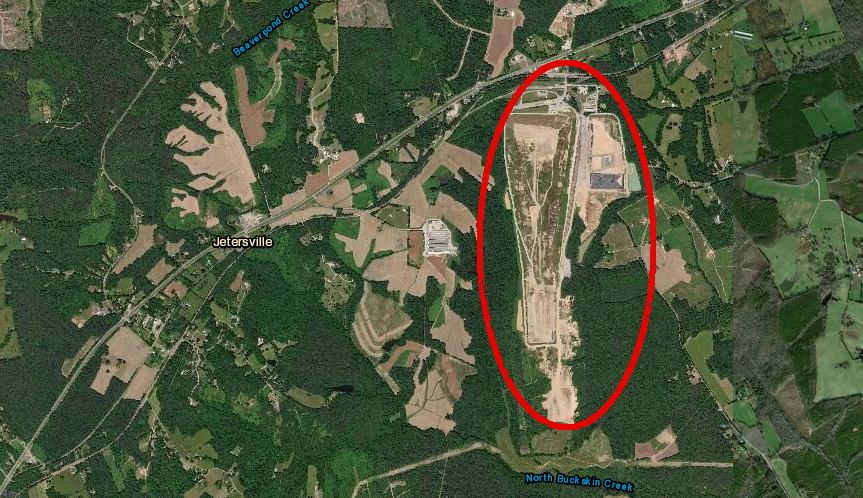
the landfill in Amelia County is located in a rural area
Source: ESRI, ArcGIS Online

the landfill in Amelia County is located in a rural area
Source: ESRI, ArcGIS Online
The Maplewood Recycling and Waste Disposal Facility in Amelia County opened in 1993. It replaced the county-operated facility and privatized the disposal of the county's municipal solid waste.
Amelia County issued a Request for Proposals and approved a deal in 1990 with Chambers Waste Systems of Virginia, which is now part of Waste Management. At the time, Amelia County had less than 9,000 residents.1
Amelia County negotiated a "host agreement" with Waste Management and issued a Conditional Use Permit for the landfill that require the company to accept waste from county agencies and charitable institutions at no cost. Residents and businesses who were in the county when the landfill contract was signed in 1990 also receive free trash disposal, though they must still pay for a company to pick up their trash. Waste Management operates five convenience centers for residents to drop off trash and recyclables for free, if they wish to avoid paying for collection costs.
The original life expectancy of the 800-acre Maplewood Recycling and Waste Disposal Facility was 20 years, and the Virginia Department of Environmental Quality permit authorized it to accept up to 7,000 tons of waste per day. The site was planned to develop in 34 phases, ultimately storing over 45 million cubic yards of waste.
In 2018, the landfill was receiving only 500 tons of waste per day, and had developed only 15 phases at 7-16 acres each. Amelia County estimated that the landfill could operate for over 100 more years. Construction of the Green Ridge Recycling and Disposal Facility in adjacent Cumberland County could divert waste from the Amelia landfill and extend its life expectancy even longer.
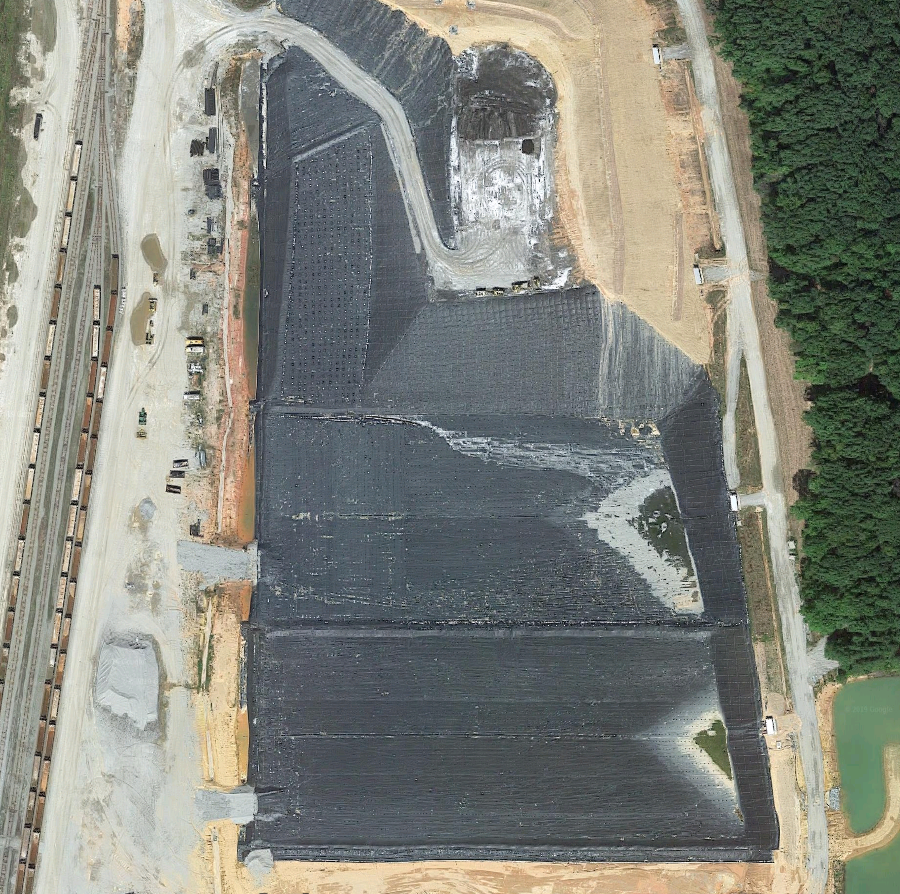
black geotextile fabric lines a new cell at the Maplewood (Amelia) Landfill, ready for delivery of waste by rail
Source: Google Maps
Waste Management pays the costs for the two county employees who oversee solid waste operations. Waste Management pays county property taxes, and the host agreement also requires Waste Management to pay Amelia County a fee for all out-of-county waste deposited at the landfill. Between 1993-2018, Amelia County received $27 million for accepting non-local waste, which was over 95% of all waste deposited.
To protect the clay cap on closed cells, 114 gas wells collect methane. The gas was initially just burned ("flared") as a waste product. Later, INGENCO was contracted to install 48 engines that can burn a combination of diesel and methane, with each engine generating up to 350kW. Together, the 48 generators can produce up to 16MW of electricity, when a supply of diesel supplements the methane as well as facilitates ignition. With just minimal use of diesel, 9MW can be generated.2
Starting in 2015, the landfill received 1.5 million pounds from a Duke Energy coal ash impoundment at the Dan River Steam Station in Eden, North Carolina. A pipe failed in 2014, and 39,000 tons of coal ash flowed down 70 miles of the Dan River.
Duke then agreed to close the pond, which had no liner, and move the ash to a modern landfill. It built one next to the former pond, but while construction was underway the utility shipped ash to the Amelia landfill.
Amelia officials concurred with Waste Management and Federal officials that coal ash was not a hazardous waste, and understood the county would generate extra revenue from the extra business. County residents did not see an increase in truck traffic delivering waste to the landfill, because Norfolk Southern delivered 30 rail cars each week with the coal ash.3
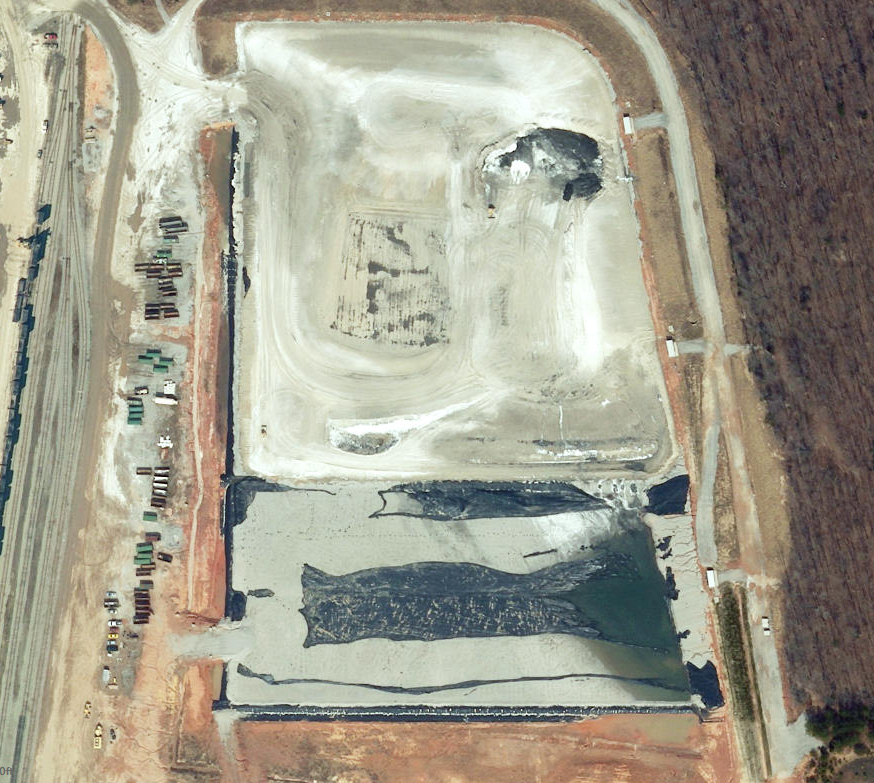
Duke Energy coal ash, delivered by rail, being deposited into Maplewood Landfill
Source: ESRI, ArcGIS Online
The landfill was designed from the beginning to receive waste via rail. After Waste Management acquired other landfills, rail delivery dropped to as low as zero in 2000-2002.
Waste delivery by rail increased after 2002. The amount delivered by rail varies, based upon Waste Management's assessment of cost-effective use of its various facilities in Central Virginia. The company is allowed to store railcars loaded with waste for up to 72 hours at the landfill, before those railcars must be emptied.

Norfolk Southern rail access to the Maplewood (Amelia) Landfill made it a preferred destination for half of the coal ash removed from the Duke Energy impoundment in Eden, North Carolina
Source: ESRI, ArcGIS Online
Waste Management was required in the host agreement with Amelia County to establish a mitigation and remediation fund. As the landfill expanded, the company had contributed $5,000/acre. With accumulating interest, the fund is expected to reach a total of $2 million. The mitigation and remediation fund was a requirement in addition to what the Virginia Department of Environmental Quality already mandated to ensure financial capacity for addressing problems during operations, and to ensure long-term monitoring after closure.
Amelia County also built into the host agreement some protection in case the landfill closed prematurely. Waste Management must include extra space to handle five years of the waste produced by the county, which would provide time for the county to find an alternative if the private company chose to close the landfill and consolidate waste disposal at a different company-owned facility.4
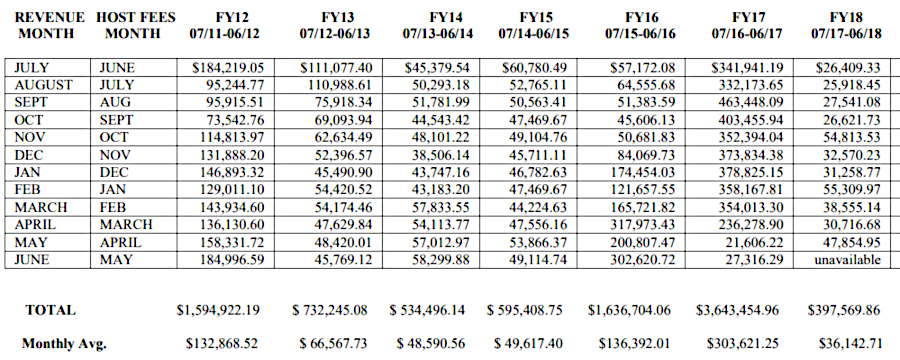
waste disposal is a business: Amelia County revenues from the landfill vary, based on the competitive position of the Maplewood facility compared to other sites
Source: Amelia County, County of Amelia Fiscal Year 2019 Budget (last item)
Amelia County and Waste Management renegotiated the 1990 contract in 2013. It still set a minimum fee to be paid to the county per ton of waste imported to the landfill from out-of-county locations. The contract also included an escalator clause.
If Waste Management increased the price that it charged customers for disposal of waste in the landfill, then the fee paid by Waste Management to Amelia County would increase by 80% of the price increase charged to customers. Fees paid to the county would decrease by 80% of customer price decreases, but never below a base fee defined in the contract.5
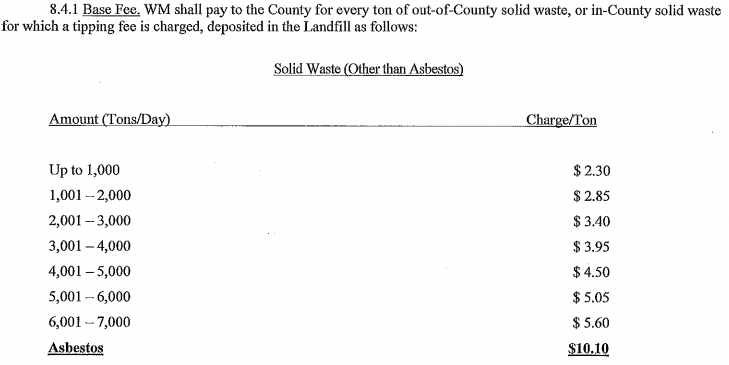
Amelia County established a minimum host fee for disposal of out-of-county trash, with adjustments for fee increases/decreases based on changing prices charged to customers
Source: Amelia County, Amelia County Maplewood Landfill Solid Waste Agreement (p.5)
Waste Management partnered with the Environmental Protection Agency between 2002-2008 to use the Maplewood landfill as one of the pilot projects for testing how decomposition could be accelerated within a landfill. Leachate, the liquid produced by decomposition, is normally pumped out of a landfill and sent to a wastewater treatment plant. The pilot test recycled leachate back into two closed cells in the Maplewood landfill, to see if maintaining a higher level of moisture would stimulate more bacteria to break down organic materials quicker.
If the decomposition process could be sped up, then the landfill would become a "bioreactor." The cap of the landfill would settle faster, and the time for leak monitoring could be reduced. Recycling leachate could also reduce operating costs, eliminating the hauling and processing at a wastewater treatment plant.
When the pilot ended in 2008, results were inconclusive. The cap over the bioreactor test cells dropped faster than over the two control cells, but the leachate and biogas production in all cells remained similar. The test ended after compaction of the waste made it difficult for the leachate to seep into the test cells.6
As of the end of 2017, the landfill had received about 400,000 tons of waste. Total capacity was 16.5 million tons. The Virginia Department of Environmental Quality estimated in 2020 that, at the rate of waste being brought to the site, the facility could operate for another 125 years.7

the Environmental Protection Agency supported bioreactor pilot testing at the Maplewood landfill in Amelia County in 2002-2008
Source: Environmental Protection Agency (EPA), Bioreactor Landfills (p.5)
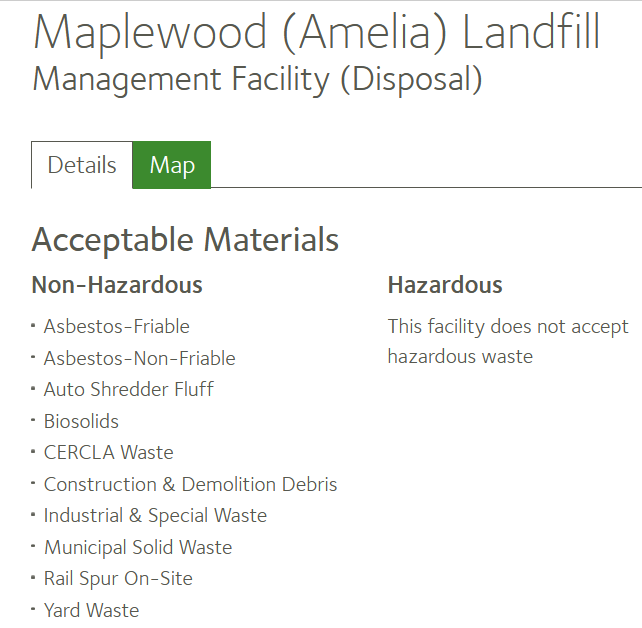
the Maplewood landfill accepted no hazardous waste
Source: Waste Management, Maplewood (Amelia) Landfill